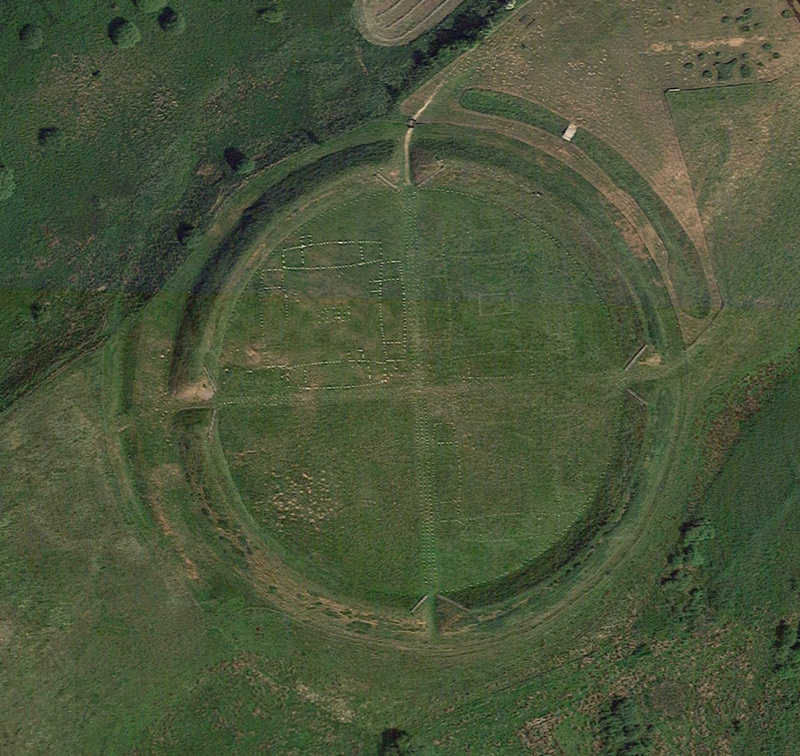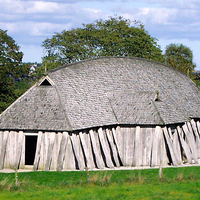Fyrkat ring fort
Date:
ca. 980
Location or Findspot (Modern-Day Country):
Denmark
Dimensions:
120 m interior diameter
Description:
There are at least six so-called ring forts that the king of Denmark Harald Bluetooth (r. ca. 958–ca. 986) built around 980 to control major waterways and roads. The fort at Fyrkat (in northern Denmark) is circular in form, like the others, with an interior diameter of 120 meters. The circle, about 13 meters thick and 3 meters high, was created from earth and turf removed from the surrounding V-shaped ditch. A wooden palisade added additional protection to the ramparts, which stood about 10 meters from the 8-meter-wide ditch. Four gates face the compass directions and are connected by roads paved in wood that meet in the center of the circle; an elevated structure marked the convergence.
In each quadrant of the ring were four longhouses built of oak (28.5 m long, 5 m wide at the ends) arranged in a square, with a smaller house at the center. These longhouses—known as Trelleborg-type houses because they were first identified at the ring fort with that name—have a main space twice the length of the room at each end, with small entrance vestibules on each long side. While some were residences, two of the longhouses at Fyrkat contained smithies and two more were used for goldsmithing, so the function of the fort was commercial as well as military. Just outside the fort were graves of about thirty men, women, and children, including one woman, buried in a cart stocked with valuable objects and psychoactive seeds that identify her as a sorceress.
In conjunction with fortified towns, the distribution of the ring forts in the landscape may have provided effective defense against raids, such as those initiated by Emperor Otto II (r. 973–83). Yet in a part of Europe that had no earlier large-scale fortifications, the forts may have been mainly symbolic expressions of royal power. Their striking similarity, geometric precision, scale, and visibility proclaimed the resources and sovereignty of Harald Bluetooth. Like the Jelling site, the ring forts were abandoned within a few decades of the successful rebellion against Harald led by his son, Svein Forkbeard (r. 987–1014), who conquered Norway and England as well as Denmark.
In each quadrant of the ring were four longhouses built of oak (28.5 m long, 5 m wide at the ends) arranged in a square, with a smaller house at the center. These longhouses—known as Trelleborg-type houses because they were first identified at the ring fort with that name—have a main space twice the length of the room at each end, with small entrance vestibules on each long side. While some were residences, two of the longhouses at Fyrkat contained smithies and two more were used for goldsmithing, so the function of the fort was commercial as well as military. Just outside the fort were graves of about thirty men, women, and children, including one woman, buried in a cart stocked with valuable objects and psychoactive seeds that identify her as a sorceress.
In conjunction with fortified towns, the distribution of the ring forts in the landscape may have provided effective defense against raids, such as those initiated by Emperor Otto II (r. 973–83). Yet in a part of Europe that had no earlier large-scale fortifications, the forts may have been mainly symbolic expressions of royal power. Their striking similarity, geometric precision, scale, and visibility proclaimed the resources and sovereignty of Harald Bluetooth. Like the Jelling site, the ring forts were abandoned within a few decades of the successful rebellion against Harald led by his son, Svein Forkbeard (r. 987–1014), who conquered Norway and England as well as Denmark.
Relevant Textbook Chapter(s):
6
Repository and Online Resources:
• Read more about the Fyrkat ring fort and Harald Bluetooth.
Image Credits:
Google, Wikimedia Commons


